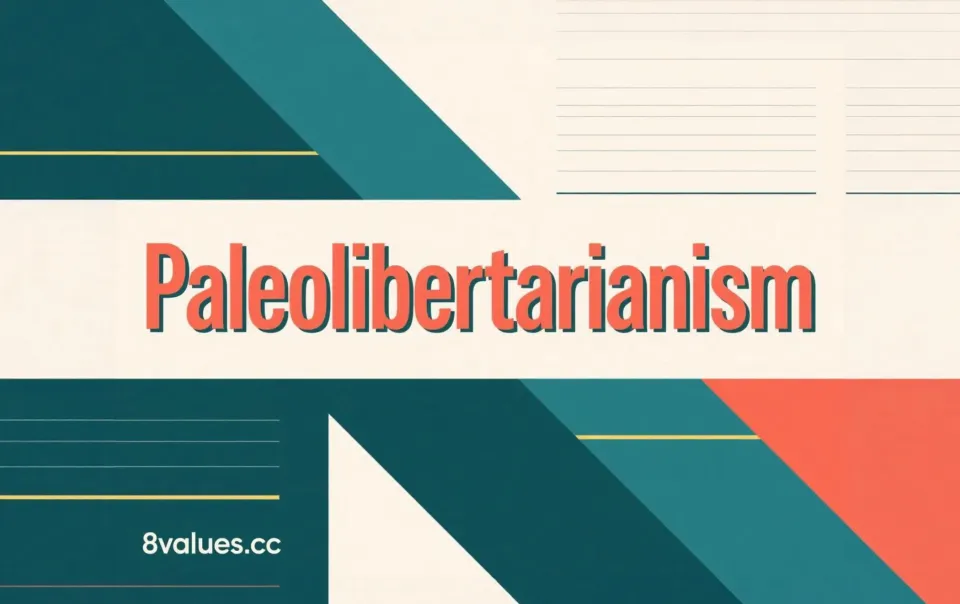Nazism | 8values Interpretation of ideological ideology in political test
Deeply explore the "Nazism" ideology in the 8values political test results. This article will provide you with a comprehensive, professional and easy-to-understand interpretation from multiple dimensions such as historical origins, core principles, economic policies, social engineering, racial concepts, and their position in the political spectrum, helping you to deeply understand the most destructive political ideas and legacies of the 20th century.
Understanding the nuances of various ideologies is crucial in today’s complex and volatile political landscape. For example, the 8values political test is a tool to help users explore their own political stances, and "Nazism" as one of the possible results undoubtedly represents one of the most extreme and destructive political ideas in human history. This article aims to conduct a comprehensive, objective and in-depth analysis of Nazism in order to maximize the reader's understanding of this complex ideology and provide detailed references to users who wish to gain an in-depth understanding of various political ideas in the full results of the 8values test .
The Origin and Times of Nazism
The rise of Nazism is not accidental, it is deeply rooted in the intense social, economic and political upheavals that Germany experienced after World War I.
National humiliation and economic crisis after World War I The defeat of World War I brought great national humiliation to Germany. According to the Treaty of Versailles signed in 1919, Germany was forced to bear responsibility for war, pay huge reparations (equivalent to about US$860 billion or £6 billion today), ceding 13% of the territory (including handing over the resource-rich industrial areas such as the Rhineland to France), and limiting military power, which laid deep resentment and revenge in the hearts of the German people. As a newly established democratic government after the war, the Weimar Republic replaced the monarchy, but was hated by many Germans for its signing of the Treaty of Versailles and was called the "November criminal". Under the severe economic situation, Germany faces problems such as high unemployment, hyperinflation (the hyperinflation crisis in 1923 caused bread prices to soar from 250 marks to 200 billion marks), and damage to industrial production capacity. The entire Europe suffered a heavy blow both economically and psychologically.
Political turmoil and social thoughts During the Weimar Republic, political polarization was severe. The left-wing Spartacus coalition tried to establish a Soviet-style government, while the right-wing extremist groups blamed the defeat of Germany on Jews, the Communist Party and the left-wing politicians, and opposed democracy, human rights and capitalism. Violent conflicts occur frequently on the streets, and bloody street fighting is held between the right and left armed groups. Against this background, strong nationalist and anti-Semitism thoughts spread in German society, providing fertile soil for the breeding of Nazism.
The meaning of the word "Nazi" and the evolution of the party name
Understanding the etymology of "Nazi" is crucial to grasping the essence of its ideology.
The origin of "Nazi" The term "Nazi" is not a compliment, but a derogatory term created by its opponents. It comes from the German abbreviation of "Nationalsozialist" (national socialist), consisting of "Na" of "National" (national or state) and "zi" of "Sozialismus" (socialism).
The evolution of party name The predecessor of the Nazi Party was the "Deutsche Arbeiterpartei" (DAP) founded by Anton Drexler in Munich in 1919. Adolf Hitler joined the party in 1919 and soon became the leader of the propaganda department. In 1920, when Hitler formulated a program for the party, he proposed the concept of "Nazism" and changed the party name to "Nationalsozialistische Deutsche Arbeiterpartei, referred to as NSDAP).
Analysis of "national socialism" and "national socialism" The Chinese world has long translated Nazismus as "national socialism", but this translation is ambiguity and inaccurate. "National" in German can be translated as "national" or "national". However, the core of Nazism lies in its racial and national concepts, emphasizing the superiority of the "Aryan race". The real "Staatssozialismus" (Staatssozialismus) is another story in German history, referring to a 19th century bourgeois reformist idea that aims to use state power to carry out social reform. Therefore, the accurate translation of Nazismus into "national socialism" is more reflecting its core concept of emphasizing "national" rather than "state" in the traditional sense.
Adolf Hitler's Rise and Leadership
The rise of Nazism is inseparable from Adolf Hitler's personal charm and political skills.
Hitler's early experiences Hitler was born in Austria and moved to Munich in 1913. After the outbreak of World War I, he volunteered to join the German army and served as a frontline messenger, and was awarded the first and second Iron Cross for his bravery. However, he was regarded as a "weird" by his colleagues, not sociable, has a cleanliness, and hates cigarettes, alcohol and women. After World War I, Hitler, who was treating mustard gas blindness in the hospital, felt extremely frustrated and betrayed. He blamed Germany's failure on the "stabs" of Jews, communists and left-wing politicians. He firmly believed that he was destined to "liberate Germany and make it great again."
From spy to party leader In the autumn of 1919, Hitler, under the appoint of officer Carl Mayer, attended the German Workers' Party meeting as a spy. He deeply agreed with the party's anti-communist, anti-Semitism and anti-socialist rhetoric and soon joined the party. With his extraordinary eloquence and incitemental speeches, he quickly became a central figure in the party, was appointed as the head of propaganda in 1920, and in 1921 the party's undisputed leader.
"Bergammon" and "My Struggle" In 1923, Hitler and his followers launched a "Bergammon coup" in Munich, attempting to overthrow the Bavarian government, which in turn triggered a national uprising to overthrow the Weimar Republic. The operation ended in failure, with Hitler arrested and convicted of treason and sentenced to five years in prison. In prison, Hitler wrote Mein Kampf, which elaborated on his worldview and political aspirations, including racism, anti-Semitism, theories of living space and the vision of establishing a "Great German State" ruled by the "Aryans". This book became a programmatic reading for Nazism.
Turn to "democracy" to seize power The failure of the coup made Hitler realize that seizing power through violence would not work. He decided to destroy the Weimar Republic through legal and democratic elections. Under Joseph Goebbels' propaganda strategy, the Nazi Party took advantage of the public dissatisfaction caused by the Great Depression (the Wall Street stock market crash in 1929 caused Germany's unemployment to soar to 6 million people, and industrial production fell by 40%), and attracted a large number of people through large-scale rallies, inflammatory speeches and concise and direct slogans such as "bread, work, freedom" and "bread." The Nazi Party's approval rating rose sharply in the 1930 and 1932 congressional elections, from 2.6% (12 seats) in 1928 to 37.3% (230 seats) in July 1932, becoming the largest party in Congress.
Seizing Power and Dictatorship On January 30, 1933, German President Paul von Hindenburg appointed Hitler as Prime Minister of the Union Government at the suggestion of a conservative adviser, mistakenly thought that he could be controlled through non-Nazi Party forces. However, after Hitler came to power, he immediately used the Congressional arson case (27 February 1933) as an excuse to persuade President Hindenburg to issue an emergency decree to suspend civil liberties and suppress the Communist Party. On March 23, 1933, the Nazi Party passed the Authorization Act, which allowed its cabinet to legislate without the approval of Congress or the president, marking the end of parliamentary democracy and establishing Hitler's dictatorship. The Nazi Party abolished all other parties and declared Germany a one-party state. After President Hindenburg's death in August 1934, Hitler abolished the presidency and declared himself "Führer und Reichskanzler" and became the absolute ruler of Germany, demanding that all members of the Defense Forces swear allegiance.
The core ideology and principles of Nazism
Nazism is a worldview that claims to explain everything in the world, with its core being race, biology, totalitarianism and imperialism.
1. Racism and Aryan superiority At the heart of Nazism is racism and anti-Semitism. It divides the world into "premium race" and "inferior race" and claims that the "Aryan race" (especially the Nordic Germans) is the source of all active development (art, science, technology, etc.), is the "master race" and deserves to rule the world. On the contrary, Jews are regarded as "anti-race", evil, destructive and immutable "parasitics" or "microbials" that threaten the purity and survival of the Aryan race. The Nazis also persecuted other groups such as Gypsies (Roma), disabled people, Poles, Soviet prisoners of war and African-German, considering them to be "non-human" (Untermensch, i.e., inferior people).
2. Extreme nationalism and living space (Lebensraum) Nazism emphasizes the supremacy of the state and nation, and advocates chauvinism and revengeism. They advocate seizing "living space" (Lebensraum) through external expansion and war to solve the problems of excessive population density and resource shortage in Germany. Hitler believed that as a superior nation, Germany had the right to seize land from the "inferior" Slavs and other Eastern nations and establish a huge empire across Eastern Europe.
3. Totalitarianism and Leadership Principle (Führerprinzip) Nazism advocates the high centralization of state power and implements totalitarian rule. Its core is the "leader principle" (Führerprinzip), that is, Hitler, as the "head of the People", is a representative of the overall will of the nation and has absolute power. The head of state's actions were correct, and his words were the truth, and there was no doubt. All individuals must obey the will of the country and leaders, and contribute or even sacrifice to achieve national goals.
4. Social Darwinism Nazism applies the Darwinian evolutionary concept of "survival of the fittest" to social and international relations, believing that "the survival of the fittest is the law of nature." Race's survival depends on reproduction, accumulation of land to feed the population, and maintaining the purity of the gene bank. This idea provided a theoretical basis for the Nazi genocide policy.
5. Anti-democracy, anti-communism and the use of capitalism Nazism opposes liberal democracy and Marxism, seeing them as enemies threatening the interests of the German nation. They believed that communism was part of the international Jewish conspiracy and a threat to the world, so war with the Soviet Union was inevitable. Although the Nazi Party is called the "National Socialist Workers' Party" and put forward slogans such as "destroying financial capitalism" and "eliminating interest slavery" to win the support of the bottom, its essence is extreme nationalism and racism, which runs contrary to socialist ideas. After Hitler came to power, he bloodily suppressed the left wing of the Stormtrooper (SA) through "Night of the Long Sword", consolidating his relationship with the great monopoly bourgeoisie and the army. The Nazi economic policy was not true socialism, but state capitalism, which held state control over industry under the name of maintaining private property rights.
Nazi economic policy and state controlism
Weimar Germany's disastrous economic situation deeply shaped the Nazi economic philosophy.
1. Get rid of the economic crisis Faced with the economic collapse caused by the Great Depression of 1929, Hitler promised to make the national economy a priority. The Nazi slogan "Brot und Arbeit" directly responded to the basic needs of the German people. Through large-scale public works projects such as the construction of highways (Autobahn) and the implementation of state-funded employment creation programs, Germany's unemployment rate dropped significantly, from 6 million to 4 million, and even approached zero at one time. These projects not only provided employment, but also became a symbol of Nazi propaganda, demonstrating Germany's growth and progress.
2. Economic Self-sufficiency (Autarky) and Reorganization of Armies One of the core concepts of Nazi economic policy is "self-sufficiency", that is, the economy should fully achieve internal self-sufficiency and not be affected by external forces. This concept stems from the huge impact of the Allied Navy blockade on German war efforts and people's lives during World War I. To achieve self-sufficiency, the Nazis imposed high tariffs and strict import restrictions, while vigorously developing alternative products (Ersatz), such as liquefiing synthetic fuels from coal. However, behind the appearance of the success of the Nazi economy is a secret: huge arms spending. Starting from 1933, the Nazi regime invested 35 billion imperial marks in weapons production, which far exceeded all employment creation programs and also led to a sluggish wage and longer working hours. Reorganization of arms is a key step for Hitler to realize his ambitions of external expansion and "survival space".
3. The Nazi industrial policy of the "private enterprise" under the state's control was a unique hybrid economic model, with both privatization elements and nationalization elements, but ultimately they were controlled by the state. After the Nazis came to power, they privatized the Weimar-era nationalized enterprises on a large scale to raise funds and reward supporters. At the same time, they also set up state enterprises, such as the Herman Göring Werke, to fill the gap in the private sector. By offering private enterprises “unnegotiable, lucrative contracts”, the Nazis achieved mandatory control of industry. Although nominally private property rights are retained, the state controls production, demand and prices, making these enterprises actually a tight gear of the state machine. Although this "capitalism under the disguise of socialism" model avoids a completely centrally planned economy like the Soviet Union to a certain extent, its essence is a highly monopoly state-controlling system. In order to avoid financial difficulties, the Nazi government also invented the deceptive financial instrument, the Mefo bills, as the government's "loan notes", which attracted capitalists to postpone cashing at an interest rate of 4%, providing funds for the reorganization of arms. However, this "economic miracle" is actually based on huge debts and the plunder of occupied territorial resources.
Nazi social engineering and propaganda
In order to infiltrate Nazism into all aspects of the lives of the German people, the Nazi regime implemented large-scale social engineering and propaganda programs aimed at shaping the "Volksgemeinschaft" sense of identity.
1. "Volksgemeinschaft" "People's Community" is one of the core concepts of the Nazis, emphasizing the unity, loyalty and discipline of the German people as a special nation. This concept aims to transcend class boundaries, unite all people of "pure German descent" and work together for the greatness of the country. However, this "community" is essentially exclusive, clearly distinguishing between "insiders" (purebred Aryans) and "outsiders" (such as Jews), who are seen as scapegoats and threats to the community.
2. Youth Organization and Education The Nazi regime focused on young people as the focus of ideological indoctrination. Boys must join the Hitlerjugend, while girls join the Bund Deutscher Mädel, referred to as BDM. These organizations replaced all other youth groups to cultivate the "new nationals" loyal to Hitler and Nazism through rigorous sports training, moral and ideological education. The school curriculum was also rewritten to promote racism and Nazi ideology.
3. "Strength Through Joy" (Strength Through Joy) "Strength Freude" (KdF) is an organization under the Nazi Party's German Labor Front (DAF). It aims to improve the living standards of workers and instill ideas in them by providing subsidized leisure benefits such as travel, vacation, cultural activities and sports. This includes building luxury cruises, organizing trips to foreign lands, and promoting the Volkswagen project. These benefits were designed to make German workers feel the care of the Nazi Party, thereby enhancing their loyalty to the regime.
4. Media and Propaganda Machine The Nazi Party deeply understands the power of propaganda. Joseph Goebbels was appointed Minister of National Education and Propaganda, responsible for building a cult of personality for Hitler, portraying it as the "savior" and "economic genius" in Germany. The Nazi instilled Nazi ideas into the people through all modern media means such as newspapers (such as the People's Observer), movies (such as the Victory of Will), radio, posters, large-scale rallies and parades. Portraits and statues of Hitler are everywhere, and people are asked to pay tribute to him, "Long live Hitler!" (Heil Hitler!). Through the process of "accumulative radicalization", propaganda has continuously escalated people's hatred of Jews and the Communist Party and their tolerance for national war policies. Goebbels' propaganda strategy is even called "institutional terror" by scholars. Through comprehensive control of media and education, as well as organizations that penetrate all levels of society, individuals force themselves to accept Nazi ideas, otherwise they will face the risk of unemployment or even jail.
Nazi racial policies and persecution
Nazi racism did not stay at the theoretical level, but systematically persecuted, isolated and exterminated groups that were regarded as "inferior race" through a series of laws and policies.
1. Nuremberg Laws On September 15, 1935, the Nazis enacted the Nuremberg Act, which was its first step in transforming Germany into a "race state." The bill includes the German Destiny and Honor Protection Act and the Imperial Citizenship Act. The German Destiny and Honor Protection Act prohibits Germans from intermarriage or having extramarital relations with Jews, and prohibits Jews from hiring German women under the age of 45 at home. It established the Aryans as a privileged class in German society, while the Jews became the second-class persons who were proactively persecuted. The Imperial Citizenship Act deprived Jews of German citizenship, making them "state subjects" and no longer enjoyed full political rights. These laws clearly define “who is Jewish” (those with three Jewish grandparents are Jewish), and even “mischlings” with one or two Jewish grandparents are affected.
2. Persecution targeting specific groups In addition to Jews, Nazi racist ideas also persecuted and imprisoned groups such as Roma (Gypsy), disabled people (through the T-4 euthanasia program, about 200,000 "defective Aryans" were murdered), Poles, Soviet prisoners of war and African-American Germans. The Nazis believed that these people were "untermensch" and did not meet their vision of establishing "pure Germany". Gay people were also seen by the Nazis as "degenerate behavior" and a threat to national existence. According to Article 175 of the revised German Criminal Code, about 100,000 homosexuals were arrested, 50,000 were convicted, and many were sent to concentration camps and subjected to "treatment" such as castration.
3. Final Solution and the Holocaust Over time, the Nazi persecution of Jews continued to escalate. The 1938 "Reichskristallnacht" was a national anti-Semitic violence planned by the Nazis, causing 1,000 synagogues to burn, 7,000 Jewish businesses to be destroyed, 91 Jews were killed and 30,000 people were sent to concentration camps. Nazi propaganda blamed the Jews themselves for the incident. After the outbreak of World War II, the Nazi racial policy reached its peak. They organized the "ultimate solution" against European Jews, the massive genocide program. In the Holocaust, about 6 million Jews were systematically massacred, of which more than 1 million were children. In addition to the Jews, millions of Slavs and others who are regarded as "inferior peoples" were also killed.
Nazi gender concepts and family policy
Nazism has a strict definition of the role and family structure of women, and all its policies are implemented through a racist perspective.
1. The role of women Nazi ideology defined women as “the gear in the national machine”, and its core role was to give birth to and raise the offspring of the “Aryans”. Hitler made it clear that men died on the battlefield, while women continued the nation through "eternal self-sacrifice, pain and torture." Women are confined to home, responsible for housework and family care. The Nazi Party banned women from holding political positions, deeming them unsuitable for political activities. There are also differences in views on female roles within the Nazi Party. Although Hitler and Goebbels declared that male and female roles are "different but equal", senior officials such as Alfred Rosenberg and Ernst Röhm did not hide their blatant misogyny, believing that women are only "emotional" or "despicable."
2. Encourage the birth of "Aryan" babies In order to increase the fertility rate of Aryans, the Nazi government implemented several policies:
- Marriage Loan Program : Launched in 1933, an interest-free loan (1000 Imperial Mark, equivalent to 7 months’ wages) was provided to the Aryans, on the condition that the wife had to leave the job. For every child you have, 25% of the loan is exempted. This plan successfully stimulated the baby boom in Germany in the 1930s.
- The Lebensborn Project : Initiated in 1935 by Heinrich Himmler, it aims to encourage childbirth by providing benefits to unmarried Aryan mothers, including financial assistance, medical care, child care and anonymous childbirth facilities. The plan even indoctrinated Nazi ideas by kidnapping Aryan children from occupied territories (such as Poland, the Soviet Union, Norway, etc.).
- "Germany Mothers' Cross of Honor" : Since 1938, Aryan mothers who gave birth to 4, 6 and 8 children have been awarded bronze, silver and gold medals respectively to commend their contributions to the nation and to grant them social privileges.
- Policies for minority women : In contrast to Aryan women’s treatment, Jewish women, Roma women and other ethnic minority women considered “subpar” were deprived of welfare, encouraged to stay in the labor market, and forced abortion and even sterilization. They were also forced to participate in various inhuman human experiments in concentration camps.
The relationship between Nazism and fascism
The relationship between Nazism and Fascism has been the focus of debate in academia.
Common points The two are closely related in nature, and fascism is considered the cornerstone of Nazism's development. They share many common characteristics, including:
- Violence worship and militarism : Both advocate violence, emphasizing military power and external expansion.
- Extreme nationalism : Emphasizes the supremacy of the country and nation.
- Political aestheticization and charismatic leadership : Both are good at inciting people's emotions through political rituals, propaganda and charismatic leaders and creating a "detached" national rejuvenation myth.
- Totalitarianism : They all advocate high concentration of state power, implement dictatorship, and suppress dissent.
Key differences Despite the many similarities, Nazism and fascism are still significantly different in core ideas:
- Race and the core of the state : Nazism emphasizes that "national" and "race" are the ultimate goal of the state, advocating the prosperity of the German nation at the expense of all other races. Mussolini's fascism puts the "state" above everything else, believing that cultural factors should serve the state rather than a specific race.
- The degree of anti-Semitism : Anti-Semitism is a natural core element of its ideology in Nazism and is actively exploited as an "inner enemy." In Italian fascism, anti-Semitism appeared later, more like it was introduced from Germany.
- Class concept : Nazism, at least ideologically opposed class-based society, attempted to unite the racial components of all classes.
Historically, Mussolini and Hitler were not allies from the beginning, and even had a feud in 1934 due to the Austrian issue. However, under pressure from Western countries, Mussolini finally chose to form an alliance with Hitler.
The Position of Nazism in the Political Spectrum
Putting Nazism in the traditional left-right political spectrum is a complex and controversial issue, as modern political definitions often fail to fully cover the complexity of European politics in the early 20th century.
1. Academic consensus: the far right Most scholars and political scientists agree that Nazism is a super-right, far-right or extreme right ideology. Scholars such as Gary B. Rush believe that the far right is a "militarized and millennial political ideology that advocates limited individualism and opposes modern social principles and structures." Nazism's extreme nationalism, racism, anti-democracy, anti-communism, and emphasis on traditional values are all in line with this feature.
2. Nazis themselves positioned: "third position" However, the Nazis (including Hitler himself) denied that Nazism was left or right, but instead portrayed it as a "syncretic movement" or "third position politics" . They believe that their thoughts transcend the limitations of the traditional left and right wing, opposing both Marxism (left wing) and reactionary royalist (traditional right wing) and combining it with nationalism. The characteristics of "third position politics" include: anti-Marxism, anti-capitalism, strong state intervention in the economy (but retaining personal property rights), extreme nationalism, racism, populism, militarism and expansionism. From this perspective, Nazism does show these characteristics.
3. Complexity across the times From the perspective of contemporary American politics, some Nazi policies, such as nationalized medical care, the in-depth government intervention in industry, state-funded welfare projects, etc., may be mistaken for being biased towards the left. However, this "one-size-fits-all" classification method ignores the deep essence of historical background and ideology. The Nazi view of private property rights, although nominally retained, in practice is the state's complete control over means of production, prices and demand, and is essentially a state-controlledism. Therefore, historians and political scholars stress that more accurate conclusions should be drawn through a comprehensive analysis of Nazism's policies, ideology, historical actions, and military intervention, economic, religious and social stances, rather than simply applying the modern political spectrum. Its ultimate essence, namely the infinite accumulation of individual power and totalitarian rule, is its most precise definition.
Consolidation and external expansion of the Nazi regime
After Hitler came to power and consolidated his power, he quickly implemented a policy of foreign expansion, eventually dragging the world into the abyss of World War II.
1. Suppressing dissent within the party and concentration of power On June 30, 1934, Hitler launched the "Night of the Sword" operation, bloodily purged the Stormtrooper (SA) and its leader Ernst Röhm, as well as some other conservative dissidents. The move aims to eliminate the threat of the stormtroopers to the Defence Force (Reichswehr) and its political ambitions for independence, consolidate Hitler's control over the army, and declare to the world that Germany was ruled by "gangsters". After this purge, Hitler abolished the presidency after the death of President Hindenburg and named himself the "Führer", combining the head of state, head of government and commander-in-chief of the army, achieving absolute rule over Germany.
2. Tear up the Treaty of Versailles and reorganize the armaments After Hitler came to power, he immediately began to tear down the restrictions of the Treaty of Versailles. In March 1935, he announced the re-implementation of the conscription system, expanding the size of the army from 100,000 to 500,000, openly challenging the international community. The international community's slow response to this has fueled Hitler's ambitions. In March 1936, Hitler sent troops to re-occupate the Rhineland Demilitarized Zone, violating the Treaty of Versailles again. The success of this "gambling" made him a national hero at home and further consolidated his power.
3. The merger of Germany and Austria and the annexation of Czechoslovakia In March 1938, the German army entered Austria, which was welcomed by the local people and realized the "German and Austria Merger" (Anschluss). This was promoted by the Nazis as the first step toward the "Great German Kingdom" without bleeding, and Hitler's reputation reached its peak. In September 1938, Hitler threatened to invade Czechoslovakia on the grounds of protecting German ethnic minorities in Sudetenland. At the Munich Conference, British Prime Minister Neville Chamberlain and the French government agreed to ced the Sudetenland region to Germany in exchange for Hitler's commitment to no longer have further territorial claims (i.e. the Munich Agreement). However, only six months after the agreement was signed, in March 1939, Hitler tore up the agreement and occupied the entire Czechoslovakia.
4. Invasion of Poland and the outbreak of World War II On September 1, 1939, Germany invaded Poland. Two days later, Britain and France declared war on Germany, and World War II officially broke out. Despite initial fear and frustration from the war, Hitler's reputation soared again as the German army achieved a series of rapid victories in Poland, Denmark, Norway, Belgium, the Netherlands and France. In 1940, Germany, Italy and Japan signed the Treaty of the Three Kingdoms to form the Axis powers. However, in June 1941, Germany invaded the Soviet Union, which put it in a dilemma of fighting on both sides, ultimately leading to the failure of the Axis powers.
The consequences and legacy of Nazism
Nazism and its regime have brought unprecedented disasters to Germany and the world, and its legacy still deeply affects human understanding of extremist ideas.
1. World War II and the Holocaust Nazism eventually led to the outbreak of World War II, which killed tens of millions of people, including the Holocaust in which about 6 million Jews were systematically massacred. The Nazi regime carried out large-scale economic plunder and genocide in Europe.
2. Post-war handling and historical reflection After Germany's defeat in 1945, Hitler committed suicide, and the Nazi Party was banned by the Allies and declared it a criminal organization. The Nuremberg International Military Tribunal tried major war criminals, and many senior Nazi officials were sentenced to death. After the war, Germany passed legislation and education, continuously tracking down war criminals and promoting historical reflection, and strictly prohibiting the public display of Nazi logos on any occasion.
3. The Ghost of Neo-Nazism Although the Nazi regime has been overthrown, Neo-Nazism, as a movement to revive Nazi ideology, still existed around the world during the post-war period. These groups continue to promote hatred, white superiority, anti-Semitism and racial discrimination. They use the internet and social media to expand their influence and mobilize new issues such as immigration, feminism and LGBTQ+ rights.
Conclusion: Beware of extreme thoughts
The rise and fall of Nazism is an important lesson in human history, reminding us to be wary of the dangers brought about by racism, extreme nationalism, dictatorship and the erosion of democratic freedoms. Through an in-depth understanding of the extreme ideology of Nazism, we can better identify and resist its possible variants in modern society and defend human freedom, dignity and universal values. When thinking about the ideology revealed by the political spectrum coordinate analysis tool , we must keep in mind the dark chapters brought by Nazism, learn from history, and never repeat the same mistakes. In addition, you can find more articles on political theory and its real-life applications in our blog .






